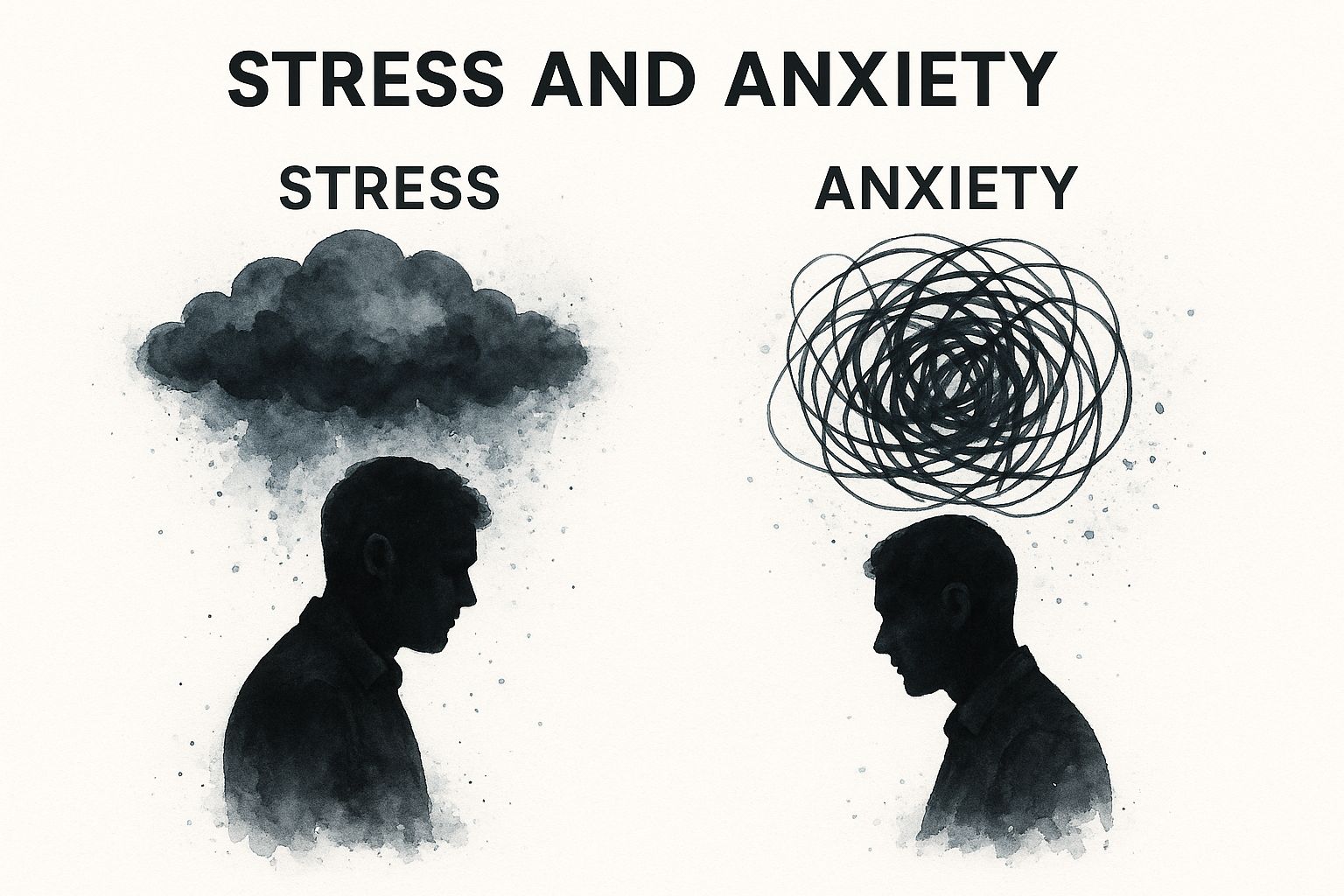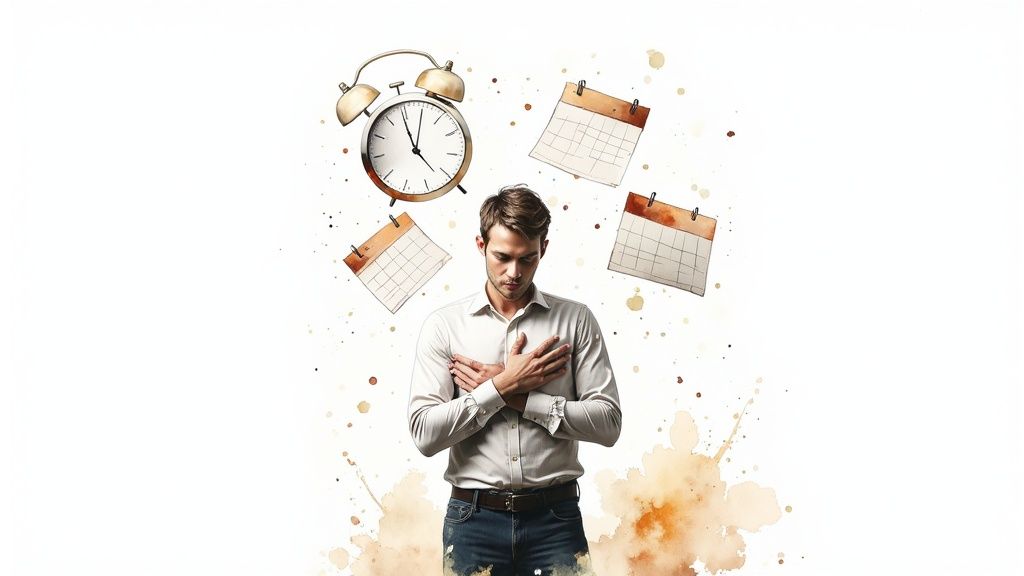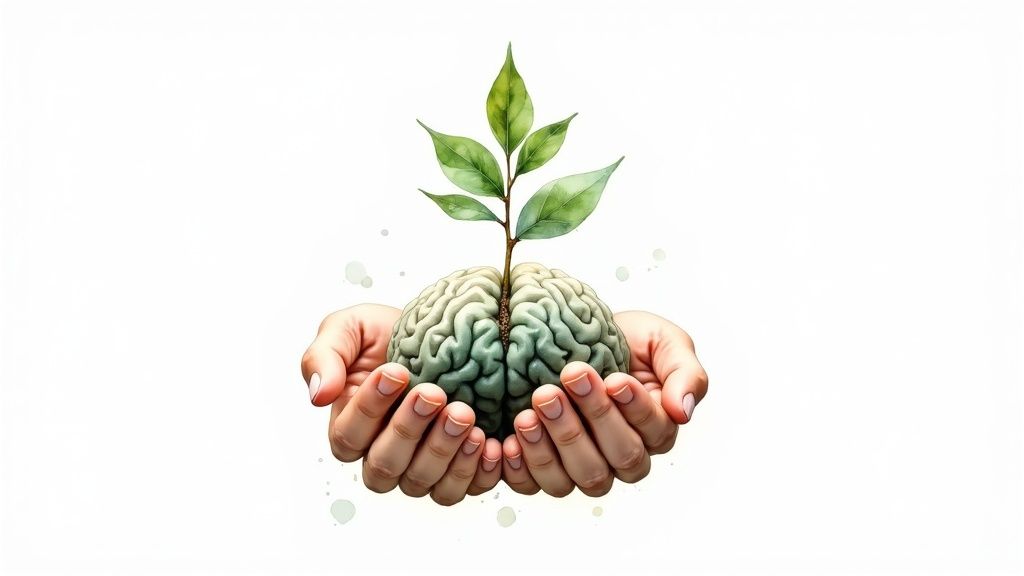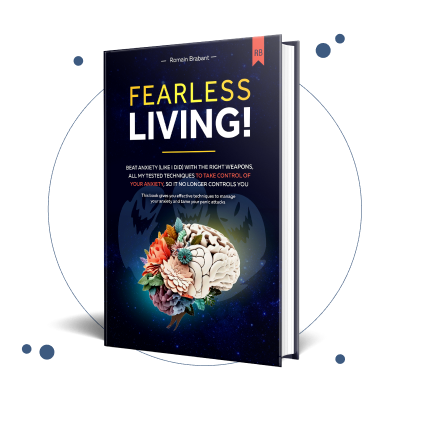
It’s easy to get stress and anxiety tangled up. People often use the words interchangeably, but they’re not the same thing—and knowing the difference is the first real step toward feeling more in control and believing that a calmer life is possible.
Here’s the simplest way to think about it: stress is a reaction to an external, identifiable trigger. It’s that feeling you get when a big project deadline is breathing down your neck or you’re about to have a tough conversation.
Anxiety, on the other hand, is an internal, persistent reaction. It can hang around long after the stressful event is over, or sometimes, it shows up without any clear reason at all.
Defining Stress vs Anxiety A Clear Path Forward
When you can accurately name what you’re feeling, you’re no longer fighting in the dark. You’re pinpointing the source, which is the foundation for finding the right way to manage it and begin to heal. This is why getting clear on the distinction is so empowering.
The visual below does a great job of highlighting the core difference. It shows stress as a direct response to a specific "storm" outside, while anxiety is more of an internal, tangled state of mind that sticks around no matter the weather.

This distinction is crucial. One is a reaction to a concrete problem right in front of you; the other is a more prolonged state of being that doesn't always need a reason to exist.
Quick Comparison Stress vs Anxiety at a Glance
To make it even clearer, let's break it down side-by-side. This table is a simple guide to help you quickly identify what you might be experiencing.
| Characteristic | Stress | Anxiety |
|---|---|---|
| Primary Cause | External, identifiable trigger (e.g., project deadline) | Internal reaction; often lacks a clear, present trigger |
| Duration | Typically short-term; resolves when the trigger is gone | Can be long-term and persistent, continuing for weeks or months |
| Emotional Focus | Frustration and pressure related to the present situation | Dread, worry, and apprehension about the future |
| Nature of Response | Reaction to a specific, real threat or challenge | Reaction to a perceived, potential, or unclear threat |
Think of it this way: stress is a normal, even necessary, part of life. Anxiety, however, can escalate into something more serious.
Globally, anxiety disorders are the most common mental health condition, affecting an estimated 359 million people in 2021. And while stress itself isn't classified as a disorder, chronic stress can absolutely pave the way for more significant challenges, including various types of anxiety disorders.
The most hopeful message is this: Understanding the root of your feelings—whether it's an external stressor or internal anxiety—is the beginning of healing. You can learn to manage these emotions and live a calmer, panic-free life.
Identifying Your Triggers and Root Causes
To really get a handle on the difference between stress and anxiety, we have to look at where they come from. Stress is almost always tied to something specific and external. Think of it as a direct response to a real-world pressure you can actually point to.
Common stressors are things like a looming work deadline, a surprise bill, or a fight with your partner. These are identifiable challenges, and the stress they cause has a clear beginning and end. Once the situation is resolved—you finish the project, you pay the bill—the stress usually backs off.
Anxiety, on the other hand, is a whole different beast. It’s far more complex and often feels like it’s coming from inside. Its roots aren’t always connected to an immediate, obvious threat. Instead, anxiety bubbles up from your perception of a threat, which can be shaped by old memories, learned ways of thinking, or even your biology.
How This Looks in Real Life
Let’s break it down with a scenario most of us can relate to.
-
A Stress Scenario: You have a massive presentation next week. You feel the pressure mounting, your heart races when you think about it, and sleep isn’t coming easy. This is stress. It’s directly linked to that presentation, and those feelings will probably vanish the second you’re done.
-
An Anxiety Scenario: You feel a constant, nagging sense of dread about your job in general. You find yourself worrying about your performance, your job security, and what your boss really thinks, even when nothing specific has happened. This persistent, free-floating unease is anxiety.
Because anxiety is so internal, it can feel mysterious and totally overwhelming. But figuring out its patterns is the very first step toward getting back in the driver's seat and on the path to healing.
Understanding your unique triggers isn’t about assigning blame. It's about gathering the intel you need to start healing. Realizing that anxiety often plays by its own internal rules is a huge lightbulb moment—one that opens the door to real, effective management and a future free from panic.
Pinpointing Your Personal Patterns
The source of anxiety is often way less obvious than a single event. It might be your reaction to uncertainty, a deep-seated fear of losing control, or even an echo from a past trauma. Someone who grew up in a chaotic household, for example, might feel anxious in calm situations simply because their nervous system is wired for high alert.
Recognizing these deeper patterns is where the real work—and the real progress—begins. You can start by just paying closer attention to when those feelings of unease pop up. Exploring some of the most common anxiety triggers can also offer some powerful clues about what might be fueling your own experience.
Ultimately, mapping out these origins—whether they’re obvious stressors or subtle internal signals—is a profoundly hopeful act. It turns a confusing, shapeless feeling into a problem you can actually solve, giving you a clear path toward choosing the right coping strategies for a calmer life.
Comparing the Physical and Emotional Symptoms
Stress and anxiety can feel incredibly similar—almost like two sides of the same coin. Both can set off your body's internal alarm system, making your heart race, your breathing quicken, and your muscles tighten up. This overlap is no coincidence; it's your body activating its ancient survival wiring, often called the fight-or-flight response.
But here’s where they part ways: duration and persistence. Think of stress symptoms as a direct, short-term reaction to a specific trigger. That headache you get before a big presentation? It usually vanishes the moment you walk off the stage.
Anxiety is different. Its symptoms tend to stick around long after a trigger is gone—or sometimes, they show up for no clear reason at all. It’s this lingering state of high alert that separates a temporary reaction from a more chronic condition.
Physical Manifestations: Stress vs. Anxiety
When you’re stressed, your body is gearing up for a short sprint. The physical signs are usually direct and temporary, designed to help you tackle an immediate challenge.
- Common Stress Symptoms: You might notice frequent headaches, nagging muscle tension in your shoulders and neck, or digestive issues like an upset stomach. It's your body saying, "Hey, I'm dealing with something right now."
Anxiety, on the other hand, keeps your body in a prolonged marathon of readiness. This can lead to more chronic and disruptive physical issues that interfere with your daily life.
- Common Anxiety Symptoms: This can look like persistent fatigue that sleep doesn't fix, trouble falling or staying asleep (insomnia), dizziness, shortness of breath, or even full-blown panic attacks where the physical symptoms feel completely overwhelming.
The real takeaway here is that stress symptoms are a direct, short-lived reaction to a problem. Anxiety symptoms are a persistent state of being that can derail your life even when there’s no obvious threat. Grasping this distinction is a crucial and hopeful step, because it empowers you to find the right path to healing.
Emotional and Mental Differences
Emotionally, the line between stress and anxiety becomes even clearer. Stress is often marked by feelings of irritability, frustration, or feeling swamped by current demands. Your thoughts are usually laser-focused on solving the problem at hand.
Anxiety, however, is defined by a pervasive and often vague sense of worry, dread, and fear about the future. It’s less about a specific problem right now and more about a general feeling that something bad is about to happen. You might find your mind racing with "what if" scenarios you can't seem to turn off.
The prevalence of anxiety disorders varies significantly across different regions and demographics. For instance, in 2021, South Asia had the highest prevalence of anxiety disorders among adolescents and young adults, with an estimated 16,949,401 cases. Globally, women are also approximately 1.6 times more likely to experience anxiety than men.
Recognizing these emotional patterns in yourself is a powerful step. When you can see that your feelings are rooted in future-focused worry, not a present-day stressor, you're better equipped to seek the right kind of support and regain a life of peace and control.
The Long-Term Impact on Health and Daily Life
It’s one thing to deal with the immediate jolt of stress or the hum of anxiety, but it’s another to see how they can quietly reshape your future. Recognizing the long-term impact is often what finally pushes us to make a real change toward a brighter, calmer future.
When left unchecked, both chronic stress and anxiety can cast a long shadow over your physical health and daily life, but they do it in very different ways.
Think of chronic stress as a slow, steady leak in your body's energy reserves. Over time, keeping your system on high alert can lead to serious physical issues, like cardiovascular problems, high blood pressure, and a weakened immune system. It’s your body’s way of screaming that it can’t stay in "emergency mode" forever.

Anxiety, on the other hand, tends to shrink your world from the inside out. It fuels avoidance behaviors—suddenly you're turning down social invites, dreading work meetings, or steering clear of places that stir up that familiar sense of worry. This can quickly spiral into social, professional, and personal isolation.
How Daily Functioning Is Affected
The ripple effects are huge. Anxiety doesn't just stay in your head; it seeps into your relationships, your career, and your ability to just be.
Anxiety disorders can cause significant distress and make it hard to function, impacting not just you but your family and community, too. In the U.S., about 42.5% of people with anxiety disorders feel a mild impact on their daily lives. But for a staggering 22.8%, that impact is severe.
The financial toll is massive, too, from healthcare costs to lost productivity. This is where you see the stark difference—stress is a reaction, but anxiety can fundamentally alter the course of your life. For a deeper look at the numbers, you can explore more anxiety statistics.
But here’s the most important thing to remember: Seeing these impacts isn’t a reason to despair. It’s the first, most powerful step toward building a healthier, calmer future. You can’t solve a problem until you acknowledge it exists.
This knowledge is your starting point. Instead of seeing these long-term effects as your destiny, view them as clear signals that it’s time to find support and learn strategies that actually work. Healing isn’t just a possibility; it's a journey you can start today.
Proven Strategies for Managing Stress and Anxiety
Knowing the difference between stress and anxiety is a great first step, but the real power comes from realizing you can actually do something about these feelings. It’s all about building a personal toolkit of practical, sustainable skills that put you back in the driver's seat. The path to a calmer, more present life isn't a quick fix, but a series of small, deliberate actions that build resilience over time.
This isn’t about just getting by; it’s about reclaiming your well-being. With the right strategies, it is absolutely possible to heal from overwhelming anxiety and live a life free from panic. The trick is to match the solution to the problem—tackling external pressures head-on while calming your internal nervous system.
Concrete Techniques for Stress Management
Since stress is your body’s reaction to an external trigger, the most effective strategies are the ones that directly reduce or manage those outside pressures. This is about tackling the problem at its source.
Effective strategies often mean getting a handle on common life pressures. For instance, learning practical strategies for balancing work and family life can significantly reduce that daily grind.
Here are a few proven ways to get started:
-
Effective Time Management: Use simple tools like to-do lists or time-blocking to prioritize your day and shrink that feeling of being overwhelmed. When you break big projects into smaller, bite-sized steps, they suddenly feel a lot less intimidating.
-
Setting Healthy Boundaries: Learning to say "no" is one of the most potent stress-reduction tools you have. When you protect your time and energy, you prevent burnout and save your capacity for the things that truly matter.
-
Engaging in Relaxation Exercises: Even just five minutes of intentional relaxation can make a world of difference. Techniques like progressive muscle relaxation—where you tense and then release different muscle groups—can quickly melt away physical tension.
These approaches are so effective because they give you a tangible sense of control over your circumstances by addressing the direct cause of your stress.
Hopeful Approaches for Healing Anxiety
Anxiety, on the other hand, calls for a different game plan. Because anxiety is an internal response, the best strategies focus on calming your nervous system and changing the thought patterns that fuel that endless cycle of worry and fear.
Healing from anxiety isn’t about trying to eliminate worry forever. It's about learning that you are more powerful than your thoughts. It’s about building the skills to observe anxious feelings without letting them take over, creating a foundation for a peaceful, panic-free life.
The goal here is to retrain your brain's response to perceived threats, and thankfully, there are incredibly effective therapeutic methods designed to do just that.
-
Mindfulness and Deep Breathing: These practices are your anchor to the present moment, pulling your focus away from all the "what if" scenarios. A simple exercise, like breathing in for four seconds and out for eight, can instantly dial down your body's fight-or-flight response.
-
Cognitive Behavioral Therapy (CBT): This is one of the gold standards for treating anxiety. CBT helps you identify, challenge, and reframe the negative thought patterns that trigger and sustain your anxiety. When you change your thoughts, you change how you feel. A great starting point is understanding how CBT works for anxiety to see just how powerful this approach can be.
-
Regular Physical Activity: Exercise is a game-changer for reducing anxiety symptoms. It releases endorphins, which act as natural mood elevators, and it helps your body process the excess adrenaline that contributes to those feelings of panic.
These aren't just temporary fixes; they are sustainable skills that build long-term mental and emotional resilience. Every time you use one of these tools, you are actively rewiring your brain for calm, proving to yourself that you have the power to manage your anxiety and create lasting well-being.
Common Questions About Stress and Anxiety

As you start to tell the difference between stress and anxiety, a lot of practical questions naturally pop up. Getting straight answers is a huge step toward feeling better. It cuts through the confusion, demystifies what you’re feeling, and reminds you that a calmer life is absolutely within reach.
When you understand these details, you can finally take action that matters. It’s about turning that feeling of being overwhelmed into one of confidence, paving the way for real healing.
Can Stress Turn into an Anxiety Disorder?
Yes, it absolutely can. Think of chronic stress as a major risk factor for developing an anxiety disorder. When your body’s alarm system is always on, it can slowly rewire your brain chemistry, making you more susceptible to constant anxiety.
The line starts to blur when the physical and mental symptoms of stress stick around long after the stressful event has ended. This can create a new, exhausting baseline where you’re always worried and on high alert.
Managing chronic stress is one of the most powerful preventative things you can do for your mental health. If your stress feels like it never lets up, talking to a healthcare professional is a brave and proactive step toward getting back in balance and preventing anxiety from taking hold.
What Is the First Step If I Think I Have Anxiety?
The single most powerful first step is reaching out to a doctor or mental health professional. They're the only ones who can give you an accurate diagnosis, rule out other medical issues, and walk you through treatment options that are actually proven to work.
Before you go, it helps to jot down some notes. Think about what your symptoms are, how often they show up, and if you’ve noticed any specific triggers. This will give your conversation a great starting point.
Remember, asking for professional help isn't a sign of weakness—it's a sign of incredible strength. It’s the starting line for your journey back to a life that isn’t dictated by panic or worry. You don’t have to do this alone, and healing is possible.
Are There Lifestyle Changes That Help Both Conditions?
Absolutely. Some lifestyle habits are powerhouses for building resilience against both everyday stress and the deeper hum of anxiety. These are the foundational pillars of your mental well-being.
-
Regular Physical Activity: Moving your body is one of the best tools you have. Exercise dials down stress hormones like cortisol and ramps up mood-lifting endorphins, giving you both immediate relief and long-term strength.
-
Prioritizing Quality Sleep: Don't underestimate the power of consistent, restorative sleep. Being sleep-deprived can make both stress and anxiety a hundred times worse. A simple, calming bedtime routine can be a game-changer.
-
Practicing Mindfulness: Techniques like meditation or even just a few deep breaths can pull you back into the present moment. This is key for calming those anxious, future-focused thoughts and taking the edge off daily stressors.
Building these habits creates a solid foundation for managing your mental health. They’re not just temporary fixes; they are skills that empower you to take back control and prove that healing is possible.
At The Anxiety Checklist, we believe everyone deserves a life that isn't overshadowed by constant worry. Our self-help system gives you the practical tools and cognitive strategies you need to manage chronic anxiety, handle panic attacks, and build resilience that lasts. Start your journey toward fearless living today by exploring our resources at https://anxietychecklist.com.

